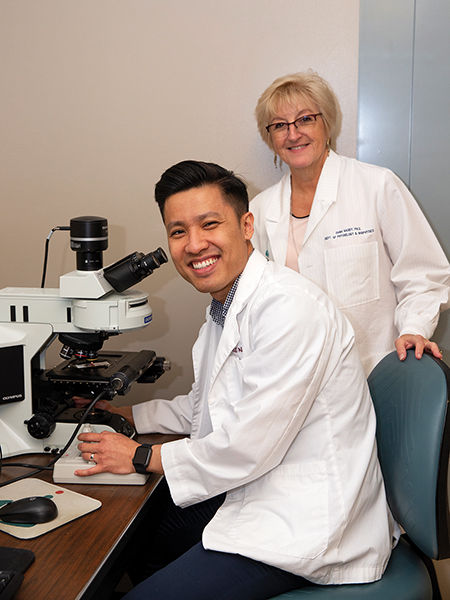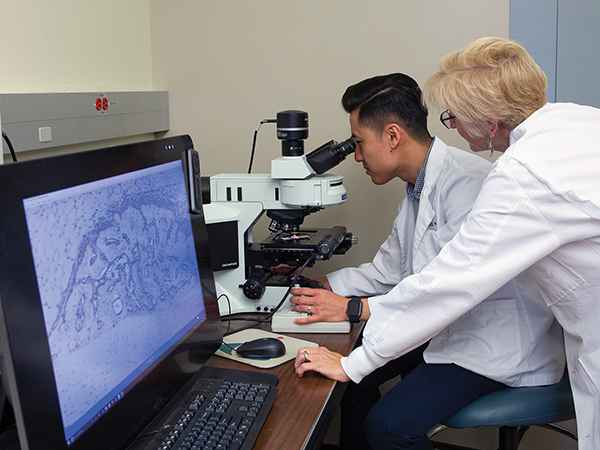Today’s Research, Tomorrow’s Cure
Story by Megan Myers, CVMBS Communications

For Duc Nguyen, research is one of the most fascinating aspects of veterinary medicine.
While he initially intended to be a child behavioral psychologist when he began studying psychology at the University of Houston, in the final year of his undergraduate degree, Nguyen suddenly realized that his true passion was for animals and veterinary medicine.
“I always had an interest and love for animals, but I had this strange fear that if I made a career out of it, my love for animals would go away,” Nguyen said. “My wife, who was my girlfriend at the time, said I was being irrational and convinced me to go for it. Women are always right, so I’m glad I listened to her!”
Nguyen never really considered other veterinary schools outside of Texas A&M; he wanted to stay close to his mother in Houston, where he lived for the majority of his life after emigrating from the small province of Tay-Ninh, Vietnam.
“My mom is a single parent and isn’t fluent in English so Texas A&M allows me to be closer to her if she ever needs my help,” he said.
Once Nguyen decided he wanted to become an Aggie veterinarian, he began looking for ways to make his application stand out. He soon became involved in research work in an ophthalmology lab at the University of Texas Health Science Center.
His lab studied zebrafish and mouse genetics to gain insight on a genetic mutation that causes Retinitis Pigmentosa, a disease in humans that causes death of the photoreceptor cells in the eye, which translate light into electrical signals that the brain can understand.
While mammals only have photoreceptor cells, zebrafish also have rod progenitor cells, which have the ability to repair retinal damage.
“Mammalian retinas have no mechanism to reverse photoreceptor cell death, but by examining the incredibly advantageous, regenerative properties that zebrafish rod progenitor cells have, the study could lead to finding therapeutic treatments for one of the leading causes of blindness,” Nguyen said.
From this experience, Nguyen discovered his love for research and laboratory animal medicine.
“I had an amazing principal investigator who always encouraged me to attend journal clubs and research seminars, which really cultivated my interest in biomedical research,” he said. “I also got to work extensively with the animals and really gained an appreciation for what they give to science. I definitely lucked into the field.”
Once he began his veterinary classes, Nguyen continued to look for opportunities to get involved in research. Since then, he has learned to appreciate the role that lab animal veterinarians play in supporting and protecting animals.
In the summer of 2017, he was accepted to the CVM’s Veterinary Medical Scientist Research Training Program to study cellular response at the site of injury of Staphylococcus aureus infected femurs.

Staphylococcus aureus, or staph, as it is often known, is a common germ that can lead to serious, and sometimes fatal, infections if it makes its way to the wrong place. Better understanding the cellular response to this infection will help equip healthcare professionals with more effective treatment methods.
“I gained so many invaluable experiences from the research training program,” Nguyen said. “I learned a ton and had first-hand experience writing a research proposal, abstract, and manuscript; producing a poster; and getting to present that poster at a research seminar.
“I also traveled to the National Institutes of Health in Washington, D.C., to present my poster with my friends, which was really fun.”
After graduation, Nguyen hopes to return to Houston to work as a clinical lab animal veterinarian in academia and collaborate on many research projects.
“I enjoy having the ability to be involved and up-to-date with the latest biomedical research, as well as having access to a very diverse patient population,” he said. “I like all fields of research, but I have a special interest in cancer research.”
“Even from my limited experience in research, I’ve witnessed some incredible breakthroughs in cancer research, which is really exciting,” he said. “However, there are still so many more questions we can answer. I can’t say I will be the person to cure cancer, but as a lab animal veterinarian, my hope is that I can serve as a conduit for the field of cancer research.”
In all areas of research, lab animal veterinarians can have a big impact on the health and safety of animals involved and on the research itself. By responsibly caring for lab animals, Nguyen’s contributions to today’s research will support the future of both animal and human medicine.
“If we want to continue developing drugs, medical devices, and diagnostic tools that help both humans and animals, we have to all work together to raise awareness of the vital role animals play in biomedical research,” Nguyen said. “By doing so, we can continue to save lives.”
###
Note: This story originally appeared in the Spring 2020 edition of CVM Today.
For more information about the Texas A&M College of Veterinary Medicine & Biomedical Sciences, please visit our website at vetmed.tamu.edu or join us on Facebook, Instagram, and Twitter.
Contact Information: Jennifer Gauntt, Director of Communications, Texas A&M College of Veterinary Medicine & Biomedical Sciences; jgauntt@cvm.tamu.edu; 979-862-4216


